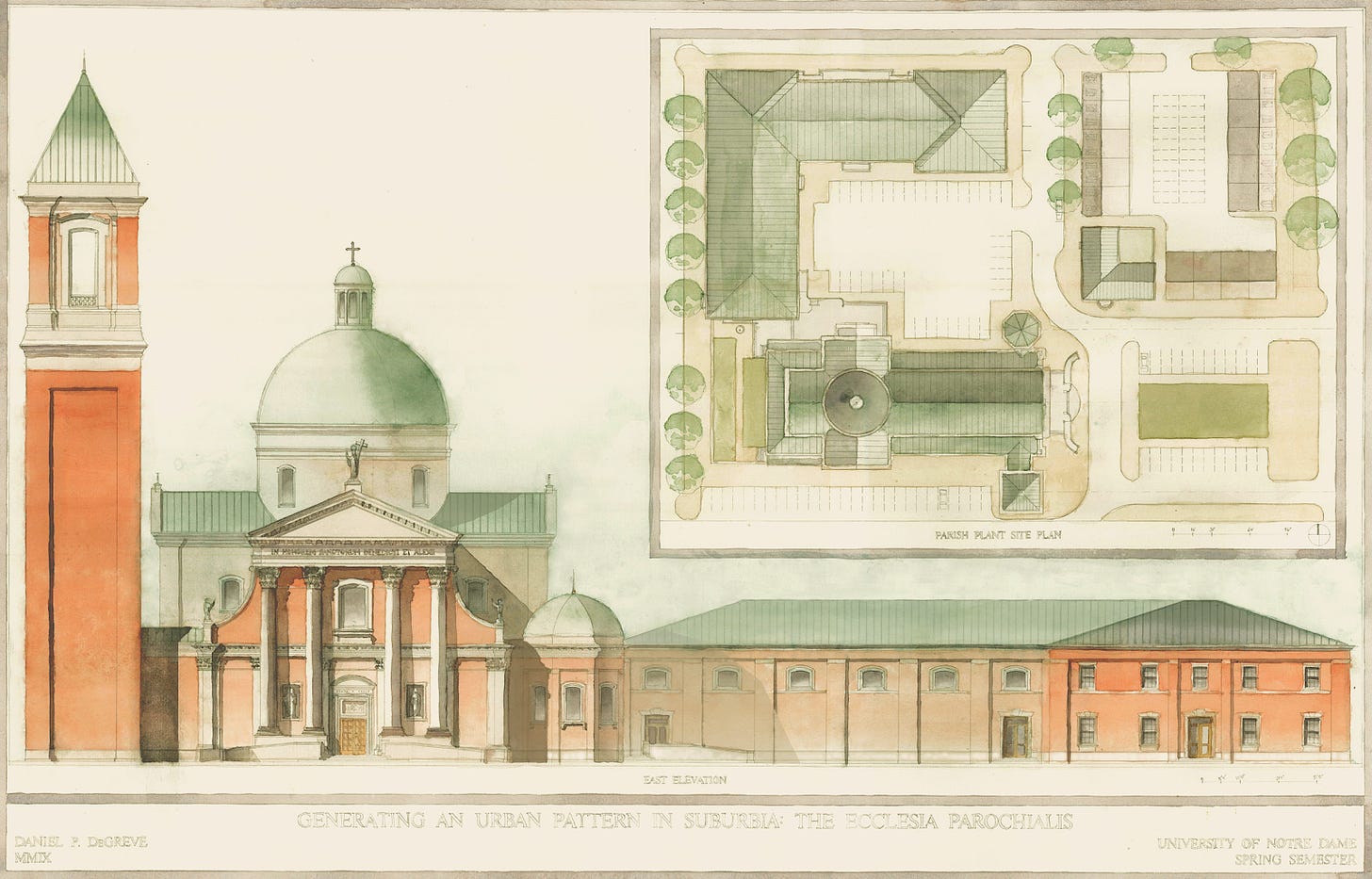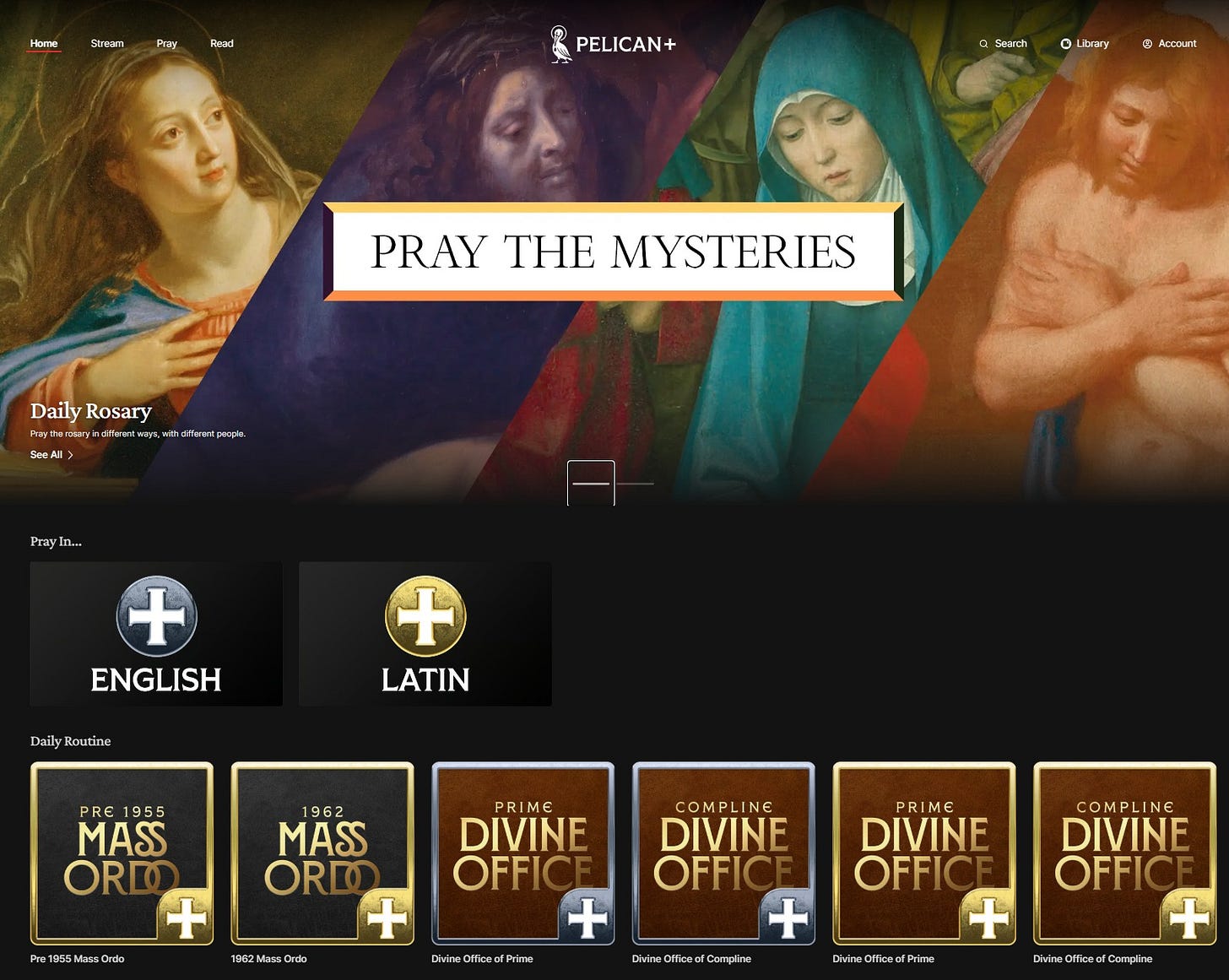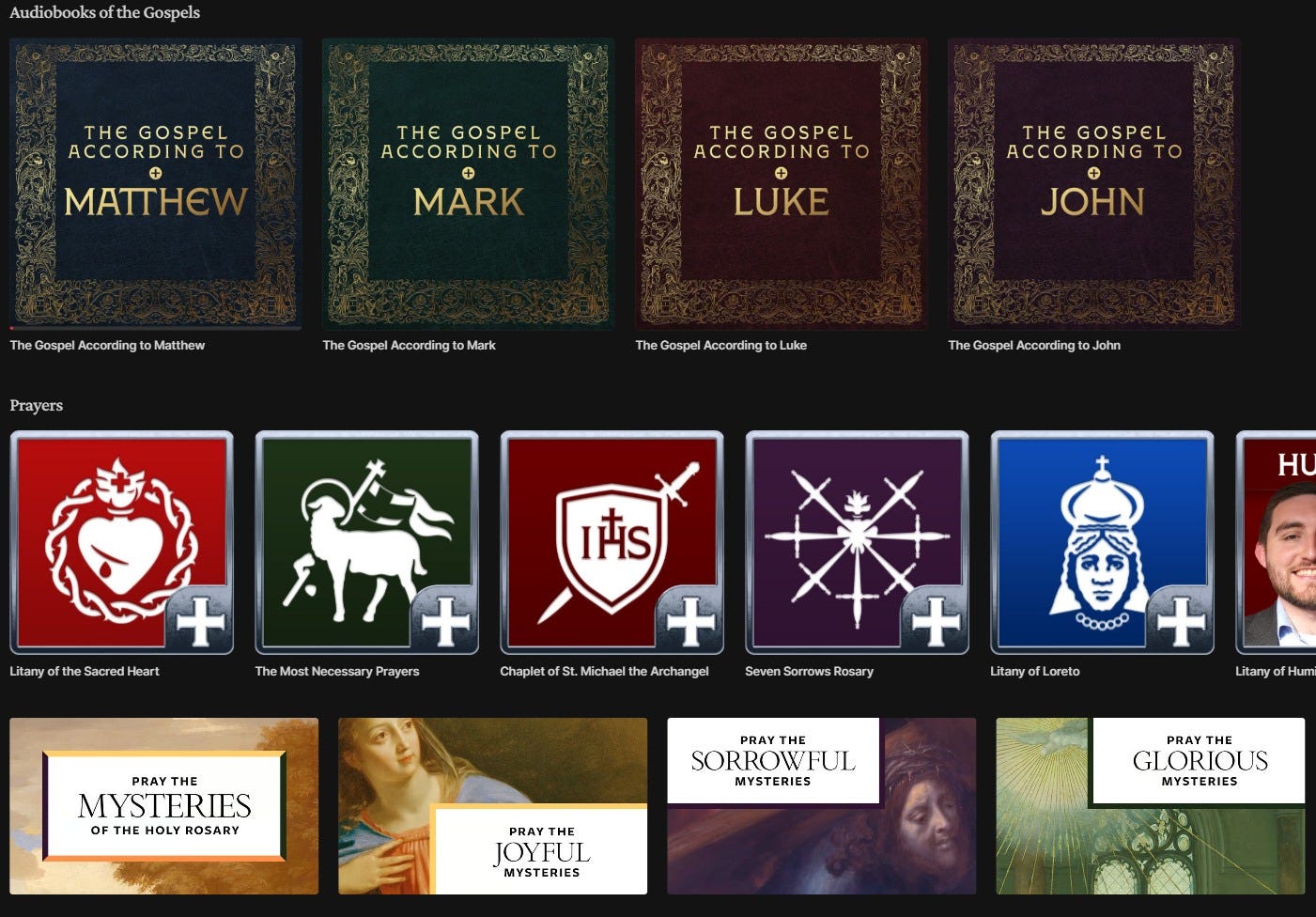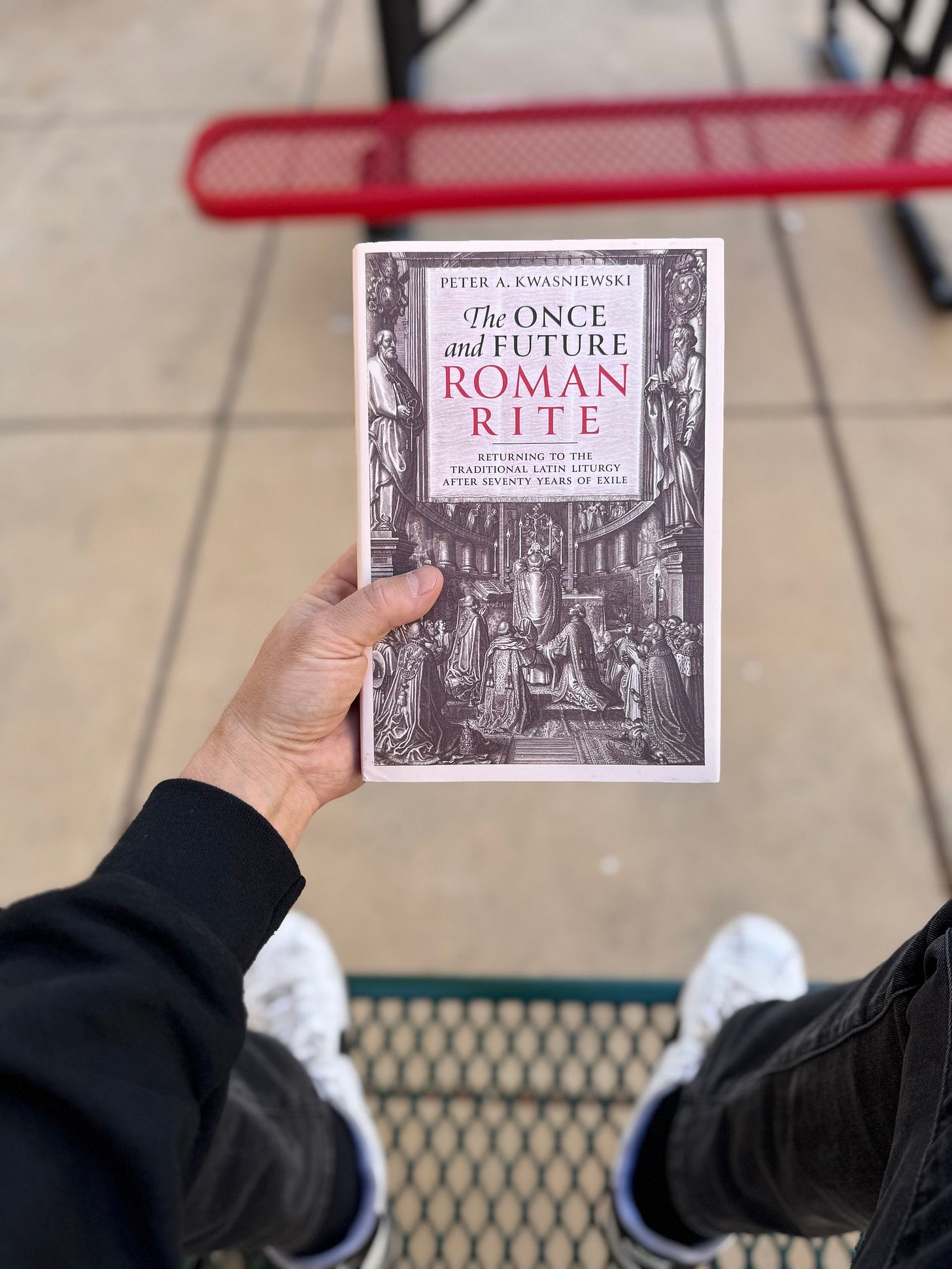Weekly Roundup, October 10, 2025
NOTE: As of December 1, Tradition & Sanity will move permanently to Pelican+. After that point, this Substack will publish only article teasers, with the substance over there. Between now and December 1, posts will be published at both places. In this transitional phase, I encourage you to check out Pelican+, a multi-author, multi-media traditional Catholic platform of which I am excited to be a co-founder. -PAK
The Conor Gallagher Show
Last week, I was in Charlotte, NC, recording two podcasts with Conor Gallagher, the head of TAN Books. The first of these has just been released. Consider it as a follow-up on my conversation with Matt Fradd on Pints with Aquinas (which, by the way, surpassed 100K views yesterday). Although there’s a bit of overlap, this conversation went in different directions and was more nitty-gritty about liturgical details. I hope you’ll watch it.
Speaking of Pints with Aquinas… I received a delightful email from a fellow TAC alumnus and wanted to share it with everyone. Its analogy between music and liturgy absolutely hits the target.
Dear Dr. Kwasniewski, I listened to your podcast with Matt Fradd, which was the first Pints with Aquinas podcast I’ve seen. It was good. I want to address the difficulty Matt Fradd raised at the end concerning those who do not immediately love the Latin Mass. I think you are right that it can take months to come to love it.
I think the liturgy is very much like music in its manner of touching us. I once read Michael Davis’s short pamphlet “The Mass that will Never Die” and was struck by his argument that the art of the Renaissance was splendid, and how could we expect something from the 60s to compare when we see the music and architecture that arose in the 60s?
This argument made me think that I might be as poorly formed in my liturgical taste as I had once been in my musical taste. I did the “Berquist Challenge” with the Liturgy. I do not know if the Berquist Challenge was around when you were at TAC, but it is a challenge to listen only to classical music for six months with the assertion that if you do so, you will never love to listen to rock music again.
So, I tried the same thing with the TLM. The Berquist Challenge worked for me. I’ve only been driven by necessity three times in the last five years to go to the Novus Ordo, and when I have gone, it has been as painful as listening again to the old classic rock music to which I used to listen. Music forms the soul, and so does the liturgy.
I pray that you are well and that we see a revival of the Church when (not if) the TLM comes back.
John Byron Kuhner wrote some gracious words about the podcast at his Substack, for which I thank him: “Surviving the Liturgiclasm.”
Leo XIV’s Apostolic Exhortation
The pope released his first major document. In most regards, it is fine, saying nothing really new. If you feel the way I often do about Vatican documents, namely, “TL;DR,” Mark Lambert offers a a very accurate summary here. The wrap-up:
Overall, Dilexi te is a transitional text. It inherits Francis’s themes — the poor, mercy, popular movements — but wraps them in more classical theology. Leo seems to be saying: Yes, the poor remain central, but because they reveal Christ’s poverty, not because they are a political class.
Its strengths:
A robust theology of divine love and the Incarnation.
Strong condemnation of the throwaway culture.
A renewed link between Eucharist and charity.
Its weaknesses:
Repetitive moralising without clear audience or application.
Lack of nuance on economic responsibility and prudence.
Occasional lapses into sentimental or accusatory tone.
If Dilexi te is indeed Leo’s “mission statement,” it suggests a pontificate seeking balance between Francis’s pastoral populism and Benedict’s intellectual depth, between mercy and justice, between compassion and truth. It will reassure Catholics longing for orthodoxy that Leo’s theology is recognisably Catholic; yet it may disappoint those hoping for sharper doctrinal reform.
Still, the exhortation’s closing vision, of a Church purified by love, poor in spirit yet rich in mercy, offers hope that Pope Leo’s next documents will move from Francis’s sociological register to a more spiritual, Eucharistic, and Christ-centred renewal.
Rod Dreher, on the other hand, with righteous indignation, asked why in the world Leo was still droning on like Francis about how we have to welcome migrants with open arms, when they are raping children and the elderly in Europe.
While some quarters of the internet are already announcing a “Francis 2.0,” I think that’s not what we’re seeing, even if I’ll readily admit that Leo is proving to be more of a mixed bag than I had hoped. Still, it was nice to see him receive in audience one of the prelates Bergoglio hated and persecuted the most and to abrogate the first document by Francis (hopefully the first of many such abrogations).
I continue to think Gavin Ashenden’s take is more compelling overall; he writes a piece called “Pope Leo’s Moment” that I commend to your attention. It’s sort of “Kevin Tierney interpretation” on steroids. The operative question, argues Gavin, is: How does a pope right the barque without repudiating his predecessor and, by implication, turning the papal office into a game of football, as between Republicans and Democrats?
For the record, I’ll say quite plainly that I am of the opinion that Francis should be solemnly anathematized by multiple councils and popes, just as Honorius was, for he deserves it a hundred times more. The only reason it is hard to believe this will happen is the luxurious growth of hyperpapalism, which has raised the incumbents of the chair of St. Peter to a sort of semi-divine status that removes their pontificates from all normal philosophical or theological analysis. Needless to say, this bent perspective is already undergoing correction and will continue to break down as time goes on.
And if you feel tempted by Eastern Orthodoxy, give this piece by Erick Ybarra a read. Ybarra is a great one to help a person back away from the edge.
Meanwhile, the Lord will always raise up shepherds who reflect Him as the Good Shepherd, who know the truth and do the right thing at the moment called for. All praise and glory to Him!
At the Catholic Identity Conference, Bishop Athanasius Schneider, Bishop Robert Mutsaerts, Bishop Joseph Strickland, and Bishop Marian Eleganti made a formal, solemn, public act of reparation for the recent desecration of St. Peter’s [by LGBTQ+ forces].
The full act of reparation has been published at OnePeterFive.
A high-level ecumenical moment
When Austin Suggs (who runs a podcast called Gospel Simplicity) was mentioned in connection with an Erick Ybarra article some time ago, the idea came into my head to offer him a review copy of John Henry Newman’s Letter to Pusey, republished recently by Os Justi Press under the title The Virgin Mary as New Eve. He gratefully accepted the copy, read it, and then produced a wonderful 16-minute video on why he thinks Newman is largely right and offers a way forward for Protestants in thinking correctly about the Virgin Mary. At the end, he gives a shout-out to me and Os Justi Press:
I’ll credit this to Our Lady of the Rosary, who is very eager to see her separated children return to the maternal embrace of the Church, whose supreme exemplar she is.
Liturgical Lessons
Charlotte’s exile begins
Writes Sarah Cain, “Inside the Remaining Charlotte TLM” (a title not strictly accurate, since there is the Society chapel of St. Anthony’s…):
It was claimed that having the Traditional Latin Mass at parishes was divisive. So, paradoxically, faithful Catholics were forcibly divided from their parish communities and sent long distances away, that they may not worship in the same spaces as their neighbors. They were sent to a foreign place that their bishop knew was not big enough for their needs. They are prohibited from donating to its improvement, and collections are not taken. They must instead continue to donate to the parishes that no longer welcome them. We can only surmise that they are not allowed to make their worship space more functional or appropriate for the worship of the God they love.
Heartbreaking. I wonder if any pastors are beginning to regret their compliance with this whole business. “But what can we do?” My reply: read about Fr. Bryan Houghton, Fr. Yves Normandin, Fr. Paul Wickens, Fr. Gommar DePauw, Fr. George Kathrein, and many other priests like them.
Kudos to EWTN for doing such a great new segment on the Charlotte situation.
Pre-55 history enriches all
I always appreciate Fr. Michael Rennier’s perspective. In his latest post, “Should a Novus Ordo Catholic be familiar with older liturgies?,” makes a plug for a great book (if I may say so):
I want to recommend a book, written by a Benedictine Oblate, called Lumen Christi. Published by Os Justi (which is quickly building up a pretty great catalog), the book is a clear and sustained examination of developments in liturgy, easily readable by anyone and not just for experts, leading up to the promulgations of the 1962 and 1970 Missals. The author traces the reason for updates to the liturgy, when they happened, how, and what has been gained or lost in the changes.
He makes an excellent case for why some Pre-55 customs have been recovered and are in use today, such as the Holy Week used by the Institute of Christ the King, and why we might consider at least becoming familiar with other older customs. The author points out the value of these rites. I agree with him. Whether you simply want to understand the background to the Novus Ordo, or you go to a parish where the Old Mass is offered but they use, say, a Pre-55 Holy Week, it never hurts to become more informed.
From a letter received . . .
A TLM-celebrating priest sent me the following prophecy:
At some point in one’s academic and spiritual life, the Traditional Latin Mass reveals itself as something that cannot be relinquished once truly encountered.
Despite the administrative opposition it continues to meet from various quarters, it seems to me likely that within the next two decades the balance will shift decisively. Even should the current Traditionis Custodes policy remain in place, the ancient rite will continue to expand quietly, while the Novus Ordo communities will, almost inevitably, continue to contract. Already they appear somewhat exhausted, struggling to sustain their internal life and institutional forms. In the long view, a liturgical order centred on versus populum celebration and desacralised habits cannot, I think, carry the spiritual weight of the Church’s future.
This process of rebalancing, however gradual, can be hastened by sound scholarship and by the kind of ingenious and finely crafted publications that Os Iusti Press has begun to offer.
Well, thank you for saying so. And, by the way, I agree with the prognosis.
Feast of the Holy Rosary
Another Catholic priest shared his delight at discovering the riches of the pre-55 breviary for the feast of the Holy Rosary. It’s a great case-study of the reason why some of us are convinced that this is the step we need to take in order to overcome the “Bugninification” of the Roman Rite (I use that expression to refer to the general phenomenon of postwar tinkeritis).
The traditional Divine Office for this feast day provides us with a striking example of the beauty of the Church’s traditional rites of prayer and worship…. the hymns and antiphons in the traditional Office of the Holy Rosary provide the faithful with a sublime meditation on the fifteen Mysteries of the Holy Rosary itself…. The impoverishment in the 1962 Office (due to the lack of First Vespers) and the even greater impoverishment in the 1970 Liturgy of the Hours (due to a completely new and radically restructured modern Office) are just one more reason why the Church will only be able to recover the fulness of her deep and rich liturgical tradition if She returns to the liturgy as it was before the changes of 1955.
Exorcism Lite
The liturgical reform dared to change even the rites of exorcism, and, predictably, managed to botch them in the same way as it did everything else. Read more in Matthew Plese’s article.
Unparalleled heavenly chant
In “The Real Miracle of Gregorian Chant,” Charles Weaver, a professor at the Juilliard School, gives voice to exactly my own experience of 30+ years of singing chant:
In the proper chants of the Mass, the Church preserves for us an incomparable treasure, given to us as a free and entirely undeserved gift. The Gregorian Mass proper is one of the truly great works of human art. Every Sunday morning, as I get to the church worn down from all the cares and distractions of the week (“guilty of dust and sin,” as the poet has it) I am simply and repeatedly dazzled by the peerless beauty of the Gregorian music. This is a vague statement and easily dismissed as romantic, although I hope you share my view.
Scholars tend to be rather more reserved in their enthusiasms, but I was never very good at that. Indeed, I truly mean that singing the Gregorian melodies and contemplating (while singing) the relation of words and melody and their concrete historical development is the greatest artistic privilege I have, for the music suits the words in a particular way that seems almost unique to the chant that emerged from the meeting of Roman and Frankish singers in the late eighth century.
Moreover, to wander even farther from the normal path of scholarship, each proper chant has its own character and its own place in the grand drama of the liturgy, which is ordered for our sanctification and our transformation in Christ.... Lurking behind the veil of each of these imperfect performances is a melody that dresses the words of the prayer perfectly, as though in a royal robe of music, and elevates the words into something that truly partakes of heaven.
In sharp contrast
James Green, “Canticle of the Beige”:
Such [recent Catholic popular] liturgical music, like the banalities of postmodern business slogans, news and social media slop, or just about any movie made today, is bad because it soaks up our attention without really doing much of anything for us in mind, body, imagination, or soul. The music of Haas, Haugen, Cooney, Schutte, and the like tells us that we are fine as we are, “we are chosen,” and that there’s nothing we really need to do other than congratulate ourselves and maybe support the next bureaucratic panel on interfaith climate LGBT dialogue for immigration justice.
The beauty of Benedictine life
Here’s a new 6-minute video from Clear Creek Abbey about the life of traditional Benedictines. So beautiful, and so necessary in the Church.
I noticed as well that Dom Pius Mary Noonan, prior of a Benedictine monastery in Tasmania, Australia, helps us appreciate anew the chief architect of the Christian West: St. Benedict the man of prayer, the man of work, the legislator. He wanted his monks to have the Word of God deep within by constant repetition and memorization; to this theme Robert Lazu Kmita devotes an extraordinary essay, “Do Not Let the Devil Steal the Word of God.” (And for those who might think St. Ignatius and the Jesuits are responsible for the decline in spirituality, Philip Primeau mounts a defense of them.)
Laity did not want liturgical upheaval
Traditionalists have been saying for decades, largely on the basis of family stories and anecdotes, that the laity during and after Vatican II did not want the massive changes to the liturgy that were imposed on them by liturgists who “knew better.”
Nico Fassino of Hand Missal History has written a fine piece with concrete evidence to back up such claims. Have a look. In the summary offered by Tierney:
What he finds is interesting, and even surprised him: the liturgical changes were not in fact broadly popular. As many of the parts that would become the Novus Ordo were introduced to the faithful, there was a significant minority opposed to the changes. (Somewhere between 20-40% depending on the change). It was also not the elderly where this opposition was most concentrated, but among those 25-50.
I think this allows us to re-open that old wound: It is often said that you can’t blame the New Mass for the exodus of the faithful after 1969, because Mass attendance was starting to decline before it. This sheds insight as to why: the Church was ignoring the needs of the faithful trying, with clerics (and it was normally clerics who didn’t have a parish) trying to force their vision onto a faithful that either didn’t care, or didn’t want it. Is it any wonder that after 15 years of this, most of the people who didn’t want this change just left the Church quietly?
This also helps explain later actions like Traditonis custodes, actions that the faithful and the Bishops thought was a terrible idea and told the Pope it was. Yet he, like his ideological predecessors, knew better. Right up until he didn’t.
Missing the miraculous
Casey Chalk is right: “Be weird, Catholics.”
Many of us, myself included, have been bullied and hoodwinked by modernity. We think that if we talk about the miracles of the Church, those we are seeking to persuade will think us credulous dupes who are just as naive as the conspiracy theorists who obsess over stories about the Illuminati, lizard people, and alien abductions. So we focus on the Bible, history, and logic and hope that will be sufficient to convert Protestants or unbelievers, while maintaining our own reputation and credibility in an increasingly skeptical public square.
Of course, there’s obviously nothing wrong with using Holy Scripture, Holy Tradition, and historical or scientific evidence to persuade people of the truths of the Catholic Church—two millennia of Church history and magisterial teaching exhorts us to do precisely this. But if we refrain from talking about the miracles of ecclesial history, it is akin to fighting with one hand behind our back. (It might also explain why we don’t have examples of levitating saints today!)
What he doesn’t mention (does he not know?) is that, tragically, most references to miracles were systematically stripped from the prayers of the liturgical books in the “reforms” of Paul VI. If the lex orandi is the lex credendi, that certainly isn’t helping us to recover a sense of the reality of miracles.
Best online article on veiling
Leila Miller’s recent article at Crisis on why women should cover their heads at Mass is, quite simply, the single best article online on this topic (and that I can say on the basis of having researched the matter for by book “Ministers of Christ,” which devotes a chapter to it). If you want to share ONE article, let this be the one.
For a deeper dive that further develops all the points Leila touches on, check out Anna Elissa’s book Mantilla: The Veil of the Bride of Christ.
New Catholic architecture firm launches in Ohio
For some good news, read this: “The Aspiring New Architectural Practice of Daniel P. DeGreve, Architect.”
What a fantastic initiative!
Please support. A good tithing opportunity:
European Woes
Morello on the UK’s drift to totalitarianism
From “The UK’s Looming Technocratic Enslavement”:
The counter-revolutionary thinker Joseph de Maistre agreed that slavery was—contra the progressives of his time—indeed natural to human societies. He held that slavery had largely been vanquished not because it was unnatural but because, with the permeation of nature by grace, human nature had been transformed. Slavery had ebbed, he thought, because Christ had changed our hearts. Thus, when Immanuel Kant claimed that the moral law required us to see others as ends and never as means only, he wasn’t really telling us what the moral law dictated at all, but articulating what grace had done to the societies it had touched. From a Maistrean perspective, Kant was, like so many Enlightenment enthusiasts, simply stealing the things of God and labelling them the things of man.”
Auf wiedersehen, lieber Schnitzel!
Due to large numbers of Muslim children in the schools of Vienna, the classic Wienerschnitzel is disappearing from cafeterias: “Pork Vanishing from Vienna School Menus.”
The New Pentecost™at its New Pentecostiest™
I lived in the once-great country of Austria from 1998-2006, a beautiful and indeed life-changing experience. So much has changed even since then. At European Conservative:
The number of Catholics in Austria is falling sharply, while its Muslim population continues to grow. By 2024, Catholics in the population numbered 4.56 million with 71,531 leaving the church that year, compared to just over 5,000 joining or returning.
71,531 LEAVING the Church, vs. 5,000 coming in.
Burning down the house
“An ‘Antifa Kommando’ post on a far-left website took credit for the blaze that destroyed the Thurn und Taxis lodge, accusing Princess Gloria of ‘reactionary’ views.”
For all its faults (and they are many), I’ll take the USA any day
Again, at the European Conservative:
An 80-year-old Swedish woman is being prosecuted for weapons possession after a century-old rifle, forgotten in a storage unit since the 1960s, was discovered and found to still be functional. She had borrowed the gun from a shooting club as a teenager, which was legal at the time, and later stored it away, unaware it might someday be considered illegal. Authorities found the weapon while clearing out her unpaid storage unit in Söderhamn earlier this year…. The octogenarian reluctantly signed a confession during police questioning and expressed disbelief that something so innocuous from her youth could lead to criminal charges today.
Various and Sundry
The difference between moderns and pagans
I have probably said a dozen times or more, over the years, that “This new essay by Anthony Esolen is the best I’ve read in a month” (or some other period of time). He may well be the finest essayist alive. His latest at Crisis, “Uncharted Waters,” is a must-read. No one has better expressed the postmodern challenge to evangelization; and I would add that it is precisely the wasteland he describes that makes the recovery of the traditional liturgical rites of the Church all the more important, as they speak a fundamental human language of symbol and gesture with tremendous force—one that can penetrate even this frightful carapace.
Why the shift toward ugliness in modernity?
In a challenging essay, Anthony Daniels gives a profound explanation of why this shift has taken hold:
There is something more to modern ugliness than mere neglect of appearance. Neglect will lead naturally enough to shabbiness, raggedness, dirt, and so forth; but great attention is often paid to ugliness, as if it were something that was positively desired. Ugliness is not therefore simply something negative, a manifestation or natural consequence of the second law of thermodynamics, where it is merely not resisted. It is something positive, in the sense of something being targeted. Thus people often go to considerable trouble to make themselves ugly, or as ugly as possible.
Why do they drift away?
J.C. Miller, in “The Age of Disbelief: When Do People Lose Their Religion?,” lays out all the evidence that Catholics are especially vulnerable to loss of faith between the ages of 15 and 29 — but then doesn’t even mention the main reason, which is that the way the Faith is presented, both in catechesis and in liturgy, is boring, puerile, shallow, cringe-trendy, or all the above. While there is going to be some margin of loss in any demographic, it seems that traditional communities do much better retaining and passing on the Faith—something you’d THINK the Church’s leadership would care about. (If, that is, they want it to be retained and passed on...)
Vatican II as manipulated by the press
A detailed biography of “Xavier Rynne” has now been published. That was the pen name of a Redemptorist priest who wrote sensational articles during Vatican II about the fights going on behind the scenes, in order to create pressure for a liberal outcome. When he was discovered, he was nearly excommunicated, but managed to weasel out of it. Says his biographer Richard A. Zmuda:
“He was passionate about the Catholic Church and he was passionate about the changes that had to take place in the Catholic Church,” Zmuda said. And what would Father Murphy make of the church today and how it’s evolved from Vatican II? “He would love it,” Zmuda said. “He would absolutely love it.”
New school combines trades and liberal arts
We need this kind of school so much: the San Damiano College for the Trades, in Springfield, Illinois. A nice piece at the National Catholic Register tells you about how their inaugural year is going. The president, Kent Lasnoski, was on the faculty with me at Wyoming Catholic College for many years: a wonderful man and someone who can be trusted to build an outstanding school.
Further thoughts on Pelican+
There are far too many negatives in the world. I hardly need to rehearse them. What we need are pluses: ways to grow stronger in faith, to educate and nourish ourselves, accessible ways to enter into the unfathomable riches of our Catholic tradition. This is what Pelican+ offers.
I want to emphasize that Tradition & Sanity located at Pelican+ is going to remain exactly what it was and is — indeed, it will even look and feel much the same; it is simply moving to a different platform than Substack. While I enjoy Substack and will continue to follow favorite writers here, I have made the decision to help establish an enterprise that I believe is more in keeping with the foundational philosophy of Tradition & Sanity, as spelled out in the inaugural post of April 13, 2023.
Basically, if Pelican+ had existed in April of 2023, I would have started there! But it takes time to develop resources of this magnitude, and we have been pouring our efforts into preparing this launch.
A reminder about the special offer this week:
For those who enroll between October 7–14, Pelican+ is offering two complete study packages for free:
My own “Foundations of Faith in Crisis” Digital Study Kit, comprising three conferences, formatted for personal and group study: “The Mass and the End of Culture”; “A Higher Obedience”; “A Conscience at Peace,” each with workbooks, slides, reflection questions, and reading lists; and Kennedy Hall’s “Terror of Demons” complete series—his superb talks on Catholic masculinity and fatherhood, including the full videos.
This is a combined value of $194 — but complimentary for early subscribers to Pelican+ (at any level of membership).
If you’ve found my work helpful up till now, know that Pelican+ is where it will have its home going forward. And if you believe that serious Catholic formation deserves a stable home, this is a magnificent opportunity to help build one for it.
Thank you, dear readers, for the positive feedback I’ve received from you about Pelican+. I think it’s just a tremendous opportunity for all of us to create a real alternative to platforms like Hallow and YouTube. Let’s do it together! Thanks, too, for your patience with the inevitable hiccups and growig pains that come with a new site. We have a very dedicated team behind the scenes working on all the technical aspects and it’s going well.
NOTA BENE. As I mentioned in the special post on Tuesday, current paid subscribers will be received an email soon giving them an easy way to apply their Tradition & Sanity subscription to Pelican+ instead, losing none of what they have paid — indeed, gaining in the process. So, keep your eye out for that.
Speaking of Hallow, here’s their look:
Whereas Pelican+ has a much more “classic” aesthetic:
A few closing photos
Sent by a reader from the American West. A perfect book for lunch break.
My cat Weezer greets you.
At the lavender bush you can see through the window:
Thanks for reading and may God bless you!











Lots of interest in this article, thanks Dr K. Especially enjoyed the Benedictine video, the article on veiling at Crisis, and Gavin Ashenden's balanced appraisal of our new Holy Father. On the last point, I'm increasingly dismayed by the number of articles I come across who cannot find one iota of goodness in Pope Leo. Yes, we all want immediate correction to the faults of the modern Church, but do we really need only to see those things that are off or doubtful in Leo. I mean what were we hoping for? Was it Pius V or XII? I couldn't imagine how difficult a job this would be for Pope Leo to navigate, especially with a Roman Curia of a couple of thousand people, many of whom are indoctrinated in modernism, and more than happy to create an obstacle course for any reform to happen. Prudence is required here. Yes the scandal of the homosexual march into the Vatican weighs heavily, and should be rightly condemned and exorcised, but that did not mean that we should be willfuly blind to the good that is done. Perhaps this is the Bergolio effect. That tenure was so bad, that I (wrongly) came to see absolutely everything he did as evil. And that is preposterous. I'm sure he did some good, but his faults were so bad that I pulled down the shutters.
Finally, glad to read more from Sebastian Morello. I just finished his Mysticism, Magic, and Monasteries, and have moved onto The World as God's Icon: Creator and Creation in the Platonic Thought of Thomas Aquinas. Both excellent.
Another great round up, Dr K. Much to absorb. Thank you as always! And God bless.